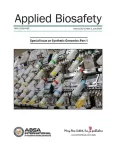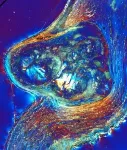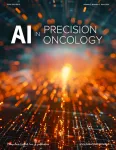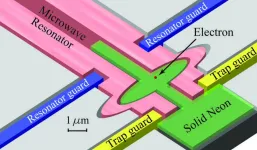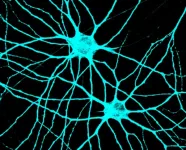(Press-News.org) In its first special issue on Biosafety and Biosecurity Considerations of Synthetic Genomics, the first part of a two-part special issue of the peer-reviewed journal Applied Biosafety focuses on the growing availability of customizable nucleic acid sequences and genomes from commercial sources. The issue also describes the advancements in desktop synthesis devices that enable the creation of on-demand nucleic acids. Click here to read the special issue now.
The rapid technological advancements described in part one of this two-part special issue are raising concerns among biosecurity experts and policymakers. The manuscripts in this issue explore the challenges, opportunities, and lessons learned in managing the risks associated with synthetic genomics.
Included in the special issue is a Review Article titled “Enhancing Gene Synthesis Security: An Updated Framework for Synthetic Nucleic Acid Screening and the Responsible Use of Synthetic Biological Materials, which reviews the U.S. government’s 2023 revised dsDNA screening framework, which now includes all entities handling synthetic nucleic acids with pathogenic or toxic sequence.
The issue also includes the Review Article titled “Developing a Common Global Baseline for Nucleic Acid Synthesis Screening, which introduces the Common Mechanism for DNA Synthesis Screening, which provides baseline capabilities to address screening challenges, facilitating broader international adoption.
Other Review Articles in the special issue include “Safeguarding Mail-Order DNA Synthesis in the Age of Artificial Intelligence”; “Screening State of Play: The Biosecurity Practices of Synthetic DNA Providers”; “Biosecurity Risk Assessment for the Use of Artificial Intelligence in Synthetic Biology”; and “A Methodology for the Assessment and Prioritization of Genetic Biocontainment Technologies for Engineered Microbes.”
“We are excited to present two Special Issues of Applied Biosafety focused on synthetic genomics, addressing the critical intersection of groundbreaking scientific advancements and the imperative for robust biosecurity measures," said David Gillum, Associate Editor. "These two issues offer essential insights and practical solutions to ensure that scientific innovations are both safe and secure, fostering a future where scientific progress and biosecurity go hand in hand.”
About the Journal
Applied Biosafety (APB) is a peer-reviewed, scientific journal committed to promoting global biosafety awareness and best practices to prevent occupational exposures and adverse environmental impacts related to biohazardous releases. APB provides a forum for exchanging sound biosafety and biosecurity initiatives by publishing original articles, review articles, letters to the editors, commentaries, and brief reviews. APB informs scientists, safety professionals, policymakers, engineers, architects, and governmental organizations. The Journal is committed to publishing on topics significant in well-resourced countries as well as information relevant to underserved regions, engaging and cultivating the development of biosafety professionals globally.
Applied Biosafety is under the editorial leadership of Coeditors-in-Chief Karen B. Byers, MS, CBSP(ABSA), Dana-Farber Cancer Institute and Barbara Johnson, PhD, Biosafety Biosecurity International, and other leading investigators.
About the Publisher
Mary Ann Liebert, Inc. is a global media company dedicated to creating, curating, and delivering impactful peer-reviewed research and authoritative content services to advance the fields of biotechnology and the life sciences, specialized clinical medicine, and public health and policy. For complete information, please visit the Mary Ann Liebert, Inc. website.
About ABSA International
ABSA International was founded in 1984 to become a global leader for providing professional and scientific expertise in the practice of biosafety and biosecurity. ABSA’s core purpose is to promote and expand biosafety and biosecurity expertise through training, standards, publications, networking, resources, advocacy, annual biosafety/biosecurity conference, and professional credentials.
END
Special Issue of Applied Biosafety focuses on synthetic genomics
2024-06-26
ELSE PRESS RELEASES FROM THIS DATE:
Simple new process stores CO2 in concrete without compromising strength
2024-06-26
By using a carbonated — rather than a still — water-based solution during the concrete manufacturing process, a Northwestern University-led team of engineers has discovered a new way to store carbon dioxide (CO2) in the ubiquitous construction material.
Not only could the new process help sequester CO2 from the ever-warming atmosphere, it also results in concrete with uncompromised strength and durability.
In laboratory experiments, the process achieved a CO2 sequestration efficiency of up to 45%, meaning that nearly ...
Osiris 39 examines the role of disability in the history of science
2024-06-26
Disability studies has gained prominence in recent years, transforming fields ranging from design to literary studies with insurgent approaches to access and representation. The newest volume of Osiris, “Disability and the History of Science,” extends this movement to ask how disability has been a central, if unacknowledged, force in the scientific disciplines and the history of science. The volume examines the many roles that disability and disabled people have played throughout the history of science, calling attention to the shaping of scientific knowledge production by disability.
Editors Jaipreet Virdi, Mara Mills, and Sarah F. Rose, in their introduction ...
AI-based Alphafold: Its potential impact on predictive medicine
2024-06-26
AlphaFold is an outstanding example of artificial intelligence’s computational capabilities in accurately predicting intricate protein structures. A new Review article explores AlphaFold’s recent advancements and its potential impact on predictive medicine. The article is published in the peer-reviewed journal AI in Precision Oncology. Click to read the articles now.
Vivek Subbiah, MD, from the Sarah Cannon Research Institute, and coauthors, describe a shift toward predictive medicine, in which AI, integrated with genomic data, ...
A heart of stone: Study defines the process of and defenses against cardiac valve calcification
2024-06-26
CHAMPAIGN, Ill. — The human body has sophisticated defenses against the deposition of calcium minerals that stiffen heart tissues, researchers at the University of Illinois Urbana-Champaign and collaborators at UCLA Health and the University of Texas at Austin found in a new study that provides the first detailed, step-by-step documentation of how calcification progresses.
“Heart disease is the leading killer annually — about 18 million deaths per year — and that number is growing. A large proportion is the result of calcification,” said study leader Bruce Fouke, a U. of I. professor of earth ...
Understanding quantum states: New FAMU-FSU research shows importance of precise topography in solid neon qubits
2024-06-26
Quantum computers have the potential to be revolutionary tools for their ability to perform calculations that would take classical computers many years to resolve.
But to make an effective quantum computer, you need a reliable quantum bit, or qubit, that can exist in a simultaneous 0 or 1 state for a sufficiently long period, known as its coherence time.
One promising approach is trapping a single electron on a solid neon surface, called an electron-on-solid-neon qubit. A study led by FAMU-FSU College of Engineering Professor Wei Guo that was ...
Review of pathogenesis, research and treatment of amyloidosis published in New England Journal of Medicine
2024-06-26
(Boston) — AL (immunoglobulin light chain) amyloidosis is a rare disease that often results in progressive organ dysfunction, organ failure and eventual death.
Clonal plasma cells in the bone marrow secrete free light chains into circulation. These light chains are part of immunoglobulins, also called antibodies. But in this disease, light chains misfold and aggregate into amyloid fibrils that deposit in organs and tissues.
In a review article of AL amyloidosis “Systemic Light Chain Amyloidosis,” Vaishali Sanchorawala, MD, director of the Amyloidosis Center at the Chobanian & ...
New research tools reveal the dynamics behind breaking a sweat
2024-06-26
Excessive heat across the United States is making this summer a season of sweat. Perspiration and its evaporation are crucial to keeping us cool when things get hot. But our understanding of how sweat evaporates is limited to the profuse phases of the process, when our bodies are coated in a sticky film or even pools of perspiration. Relatively is little is known about the dynamics behind initial phases of sweating, when tiny droplets are emitted by individual sweat glands and then quickly evaporate.
“There are mechanical engineering researchers around the world, myself included, who are devoted to understanding the different parameters of droplet behavior on ...
Neuroscience research leverages stem cells to understand how neurons connect and communicate in the brain
2024-06-26
Newly published research from Colorado State University answers fundamental questions about cellular connectivity in the brain that could be useful in the development of treatments for neurological diseases like autism, epilepsy or schizophrenia.
The work, highlighted in the Proceedings of the National Academy of Sciences, focuses on how neurons in the brain transmit information between each other through highly specialized subcellular structures called synapses. These delicate structures are key to controlling many processes across the nervous system via electrochemical ...
NRL CCOR launches on the GOES-U NOAA satellite to monitor space weather
2024-06-26
WASHINGTON – The U.S. Naval Research Laboratory’s (NRL) Compact Coronagraph (CCOR) was launched June 25, on the National Oceanic and Atmospheric Administration (NOAA) Geostationary Operational Environmental Satellite-U (GOES-U) from NASA – Kennedy Space Center to detect and characterize coronal mass ejections (CMEs).
The NOAA sponsored NRL to design, integrate, and test CCOR, a small space telescope that will create an artificial eclipse of the sun and ...
Study shows how liver damage from stress and aging might be reversible
2024-06-26
DURHAM, N.C. – While the liver is one of the body’s most resilient organs, it is still vulnerable to the ravages of stress and aging, leading to disease, severe scarring and failure. A Duke Health research team now might have found a way to turn back time and restore the liver.
In experiments using mice and liver tissue from humans, the researchers identified how the aging process prompts certain liver cells to die off. They were then able to reverse the process in the animals with an investigational drug.
The finding, which ...
